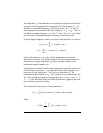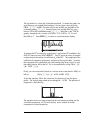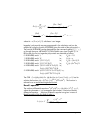
Page 16-51
Except for a large peak at t = 0, the signal is mostly noise. A smaller vertical
scale (-0.5 to 0.5) shows the signal as follows:
Solution to specific second-order differential equations
In this section we present and solve specific types of ordinary differential
equations whose solutions are defined in terms of some classical functions, e.g.,
Bessel’s functions, Hermite polynomials, etc. Examples are presented in RPN
mode.
The Cauchy or Euler equation
An equation of the form x
2
⋅(d
2
y/dx
2
) + a⋅x⋅ (dy/dx) + b⋅y = 0, where a and b
are real constants, is known as the Cauchy or Euler equation. A solution to the
Cauchy equation can be found by assuming that y(x) = x
n
.
Type the equation as: ‘x^2*d1d1y(x)+a*x*d1y(x)+b*y(x)=0’ `
Then, type and substitute the suggested solution: ‘y(x) = x^n’ ` @SUBST
The result is: ‘x^2*(n*(x^(n-1-1)*(n-1)))+a*x*(n*x^(n-1))+b*x^n =0, which
simplifies to ‘n*(n-1)*x^n+a*n*x^n+b*x^n = 0’. Dividing by x^n, results in
an auxiliary algebraic equation: ‘n*(n-1)+a*n+b = 0’, or.
.
Θ If the equation has two different roots, say n
1
and n
2
, then the general
solution of this equation is y(x) = K
1
⋅x
n
1
+ K
2
⋅x
n
2
.
Θ If b = (1-a)
2
/4, then the equation has a double root n
1
= n
2
= n =
(1-a)/2, and the solution turns out to be y(x) = (K
1
+ K
2
⋅ln x)x
n
.
Legendre’s equation
An equation of the form (1-x
2
)⋅(d
2
y/dx
2
)-2⋅x⋅ (dy/dx)+n⋅ (n+1) ⋅y = 0, where n
is a real number, is known as the Legendre’s differential equation. Any solution
for this equation is known as a Legendre’s function. When n is a nonnegative
integer, the solutions are called Legendre’s polynomials. Legendre’s
polynomial of order n is given by
0)1(
2
=+⋅−+ bnan


















